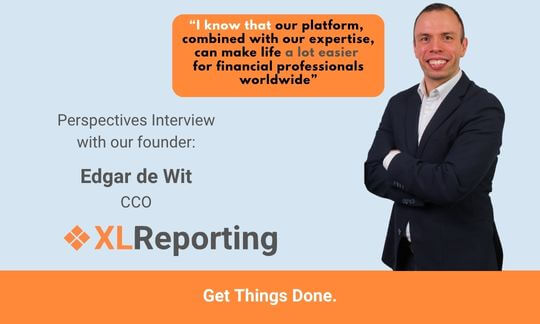
I’m responsible for marketing, sales, partner relations, and I’m also closely involved in onboarding, coordination, customer setups, and support.
What drives you as a leader within XLReporting?I know that our platform, combined with our expertise, makes life much easier for organizations and finance professionals. It gives them more time for analysis and insights. From my own experience as a financial controller and interim controller, I know how manual work, poor structures, and time-consuming tasks can drain your energy, focus, and attention. Before you know it, you’re stuck in a rat race from one month-end close to the next.
How would you describe XLReporting’s company culture, and how do you foster it within your team?We’re a fully remote organization, which gives everyone the flexibility to do their work in their own way and at the time that suits them best. I personally experience that this freedom brings out the best in people—at the right moment.
Of course, this also requires alignment, and we often do that through short and effective meetings. We keep the communication lines short, and everyone appreciates that. It helps us solve things quickly and move forward without delay.
Vision & Product PerspectiveWhat makes XLReporting different from other reporting and budgeting solutions on the market? Over the years, I’ve looked at hundreds of competitors in the reporting and budgeting space, and I still believe that XLReporting is unique.
For a solution that doesn’t come with an enterprise price tag, it’s incredibly configurable. XLReporting consists of four components: Datasets, Imports, Reports, and Models. Each block can be set up to match the organization, its processes, and configuration needs.
Most other tools are good at either reporting, or dashboards, or planning, or consolidation. Very few can do all of these. XLReporting is one of those all-in-one platforms.
How do you ensure that XLReporting continues to innovate and meet the changing needs of businesses?We listen closely to our customers and partners. They bring us suggestions based on their field, industry, and expertise. Of course, we keep the core structure as generic as possible so it can be applied broadly. At the same time, we monitor trends and how our application is used.
Because XLReporting can be used across many sectors, each user experiences it differently. These varying scenarios provide us with valuable input to improve and innovate.
What is one feature of XLReporting that users appreciate the most, and why?That would be the Planner model. This feature that lets you enter data and calculate results immediately. It works like an Excel spreadsheet, but with direct access to your data. The same model functionality can also be used to build free-form reports.
XLReporting integrates with 40+ systems, some of the most common ones are Exact Online, Xero, QuickBooks, Twinfield, and Visma (full list on our /integrations page). We also connect to databases and file sources like OneDrive and Dropbox. If a direct connection isn’t available, we can use Zapier, Dataddo, or even build custom connectors. These integrations work for both financial and non-financial data. What’s unique is the ability to configure how data is brought into the system, also technically known as ETL (Extract, Transform, Load).
Dynamic data analysis through reportsA common use case is exporting data to Excel just to be able to pivot and explore it. This step is essential for any finance professional before they start reporting—they need to understand the numbers and spot inconsistencies. Once that’s done, they can move on to deeper analysis using ratios and comparisons.
With XLReporting, once data is connected, analyses and report layouts update automatically. The time normally spent on importing, refreshing, and cleaning up data is reduced to zero—freeing up time for real insights.
How much time that saves depends on the complexity of the organization. It gets more cumbersome with multiple entities, cost centers, or large administrations.In many cases, the manual work consists of 10% downloading, 30% mapping and cleaning, 20% analyzing, and 40% reporting. With XLReporting, that entire 40% spent on downloading and cleaning is eliminated.
Can you share a success story where XLReporting made a real difference for a company?One of the success stories that continues to stand out for me is our collaboration with a accounting firm called OZCAR. They provide highly specific and detailed financial support to cultural and socially engaged organizations. Including those producing theater performances and similar initiatives.
These organizations often receive public subsidies, which require careful budgeting, consolidated financial planning, and year-end reporting that adheres to strict subsidy guidelines. OZCAR used to manage all of this through separate spreadsheets for each client.
We helped them develop a standardized setup that enables budgeting, forecasting, and reporting. In a shared and scalable structure.
This case really demonstrates the scalability of the XLReporting platform. OZCAR has now been a long-term partner, building and deploying their own reports independently, and rolling them out across their client base.
What advice would you give to organizations that struggle with financial reporting and budgeting?Take a step back. Identify where you’re stuck and why. Keep things simple. If it’s become too complex, take a pause and re-evaluate.
I believe the future lies in secure platforms that give organizations constant access to efficient and accurate analysis, forecasting, and insights.
What is the most rewarding part of your role at XLReporting?Seeing people genuinely happy with XLReporting, because it transforms how they work and even how their company operates.
If you could give one piece of advice to professionals looking to improve their reporting processes, what would it be?
Keep it simple. Look at what you’re doing, and ask yourself why.
Back to the listSchedule a Meeting with one of our Planning and Reporting Experts.
Let's Talk